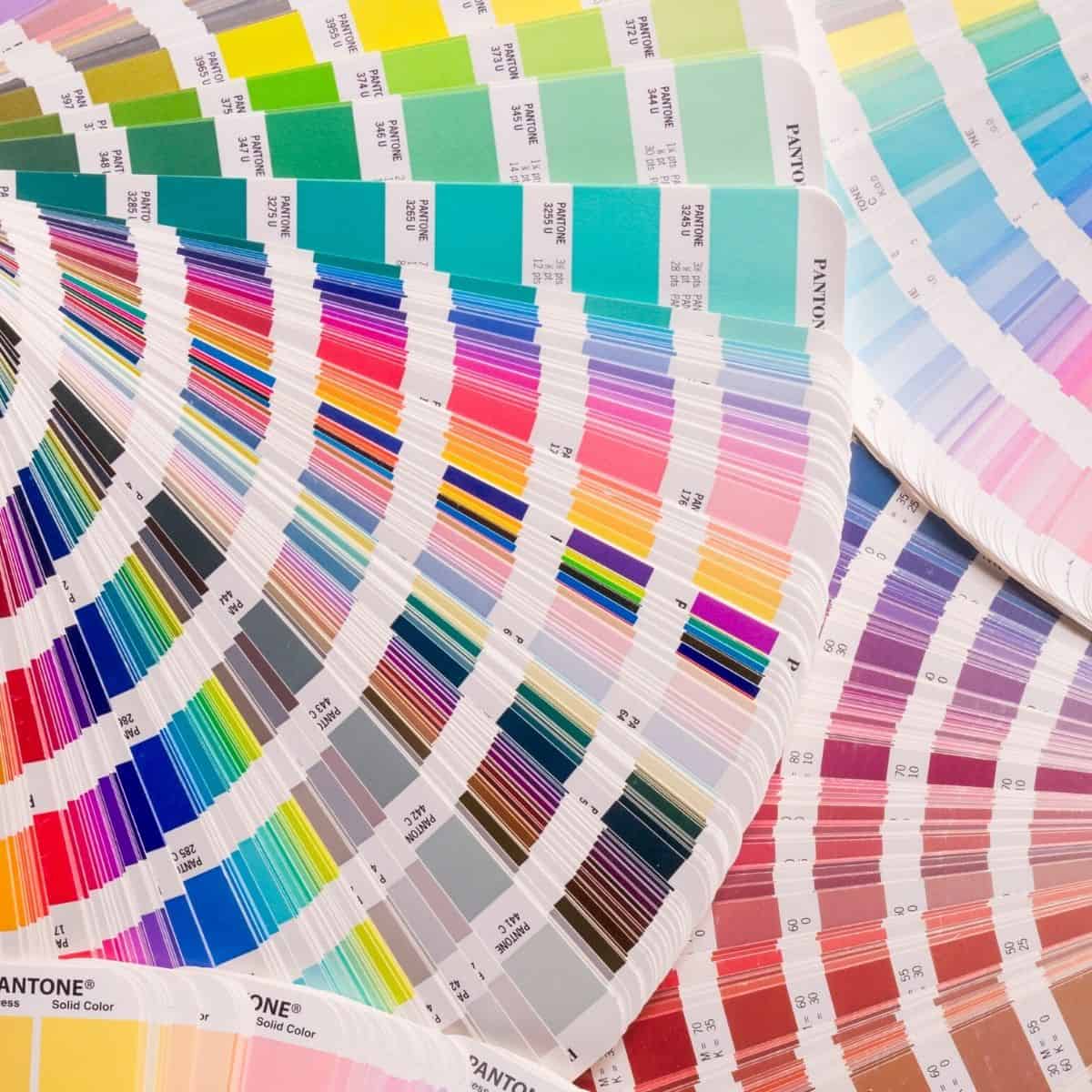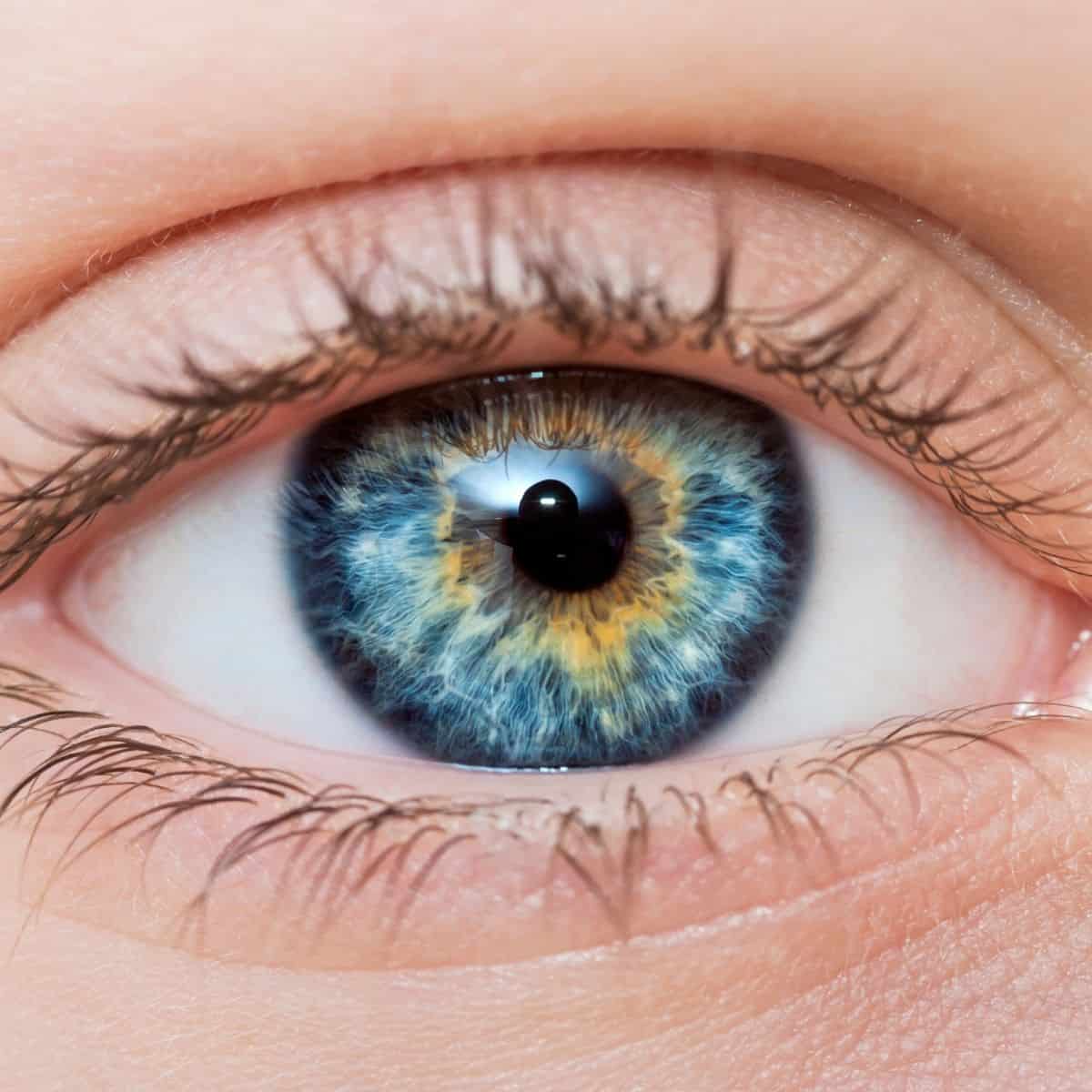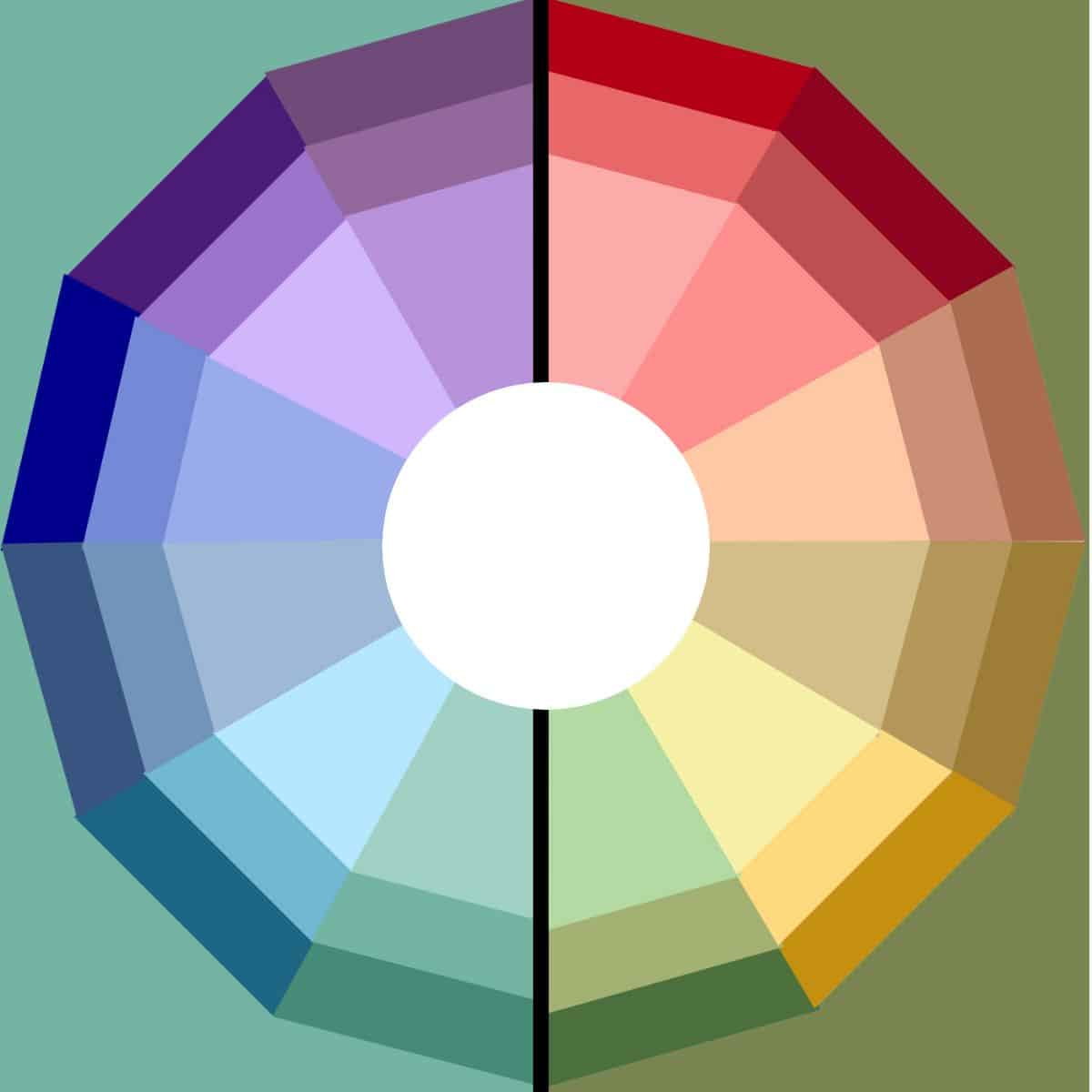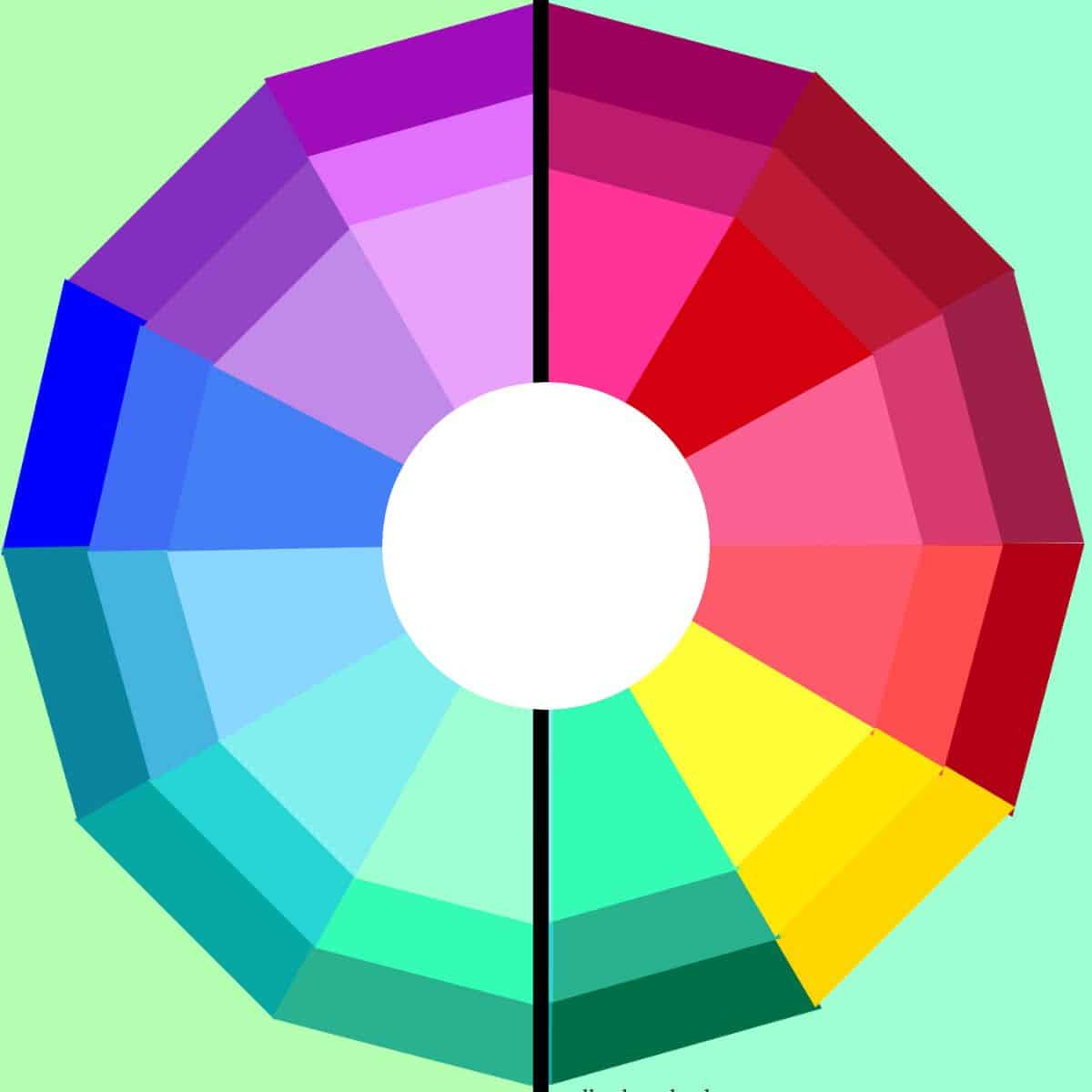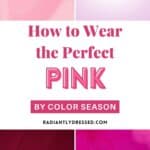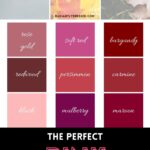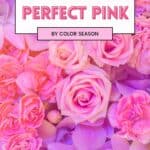Pink for Every Color Season – Find Your Perfect Pink Hue
Whether you are a spring, summer, autumn, or winter, choosing the right shade of pink adds fun and femininity to your style.
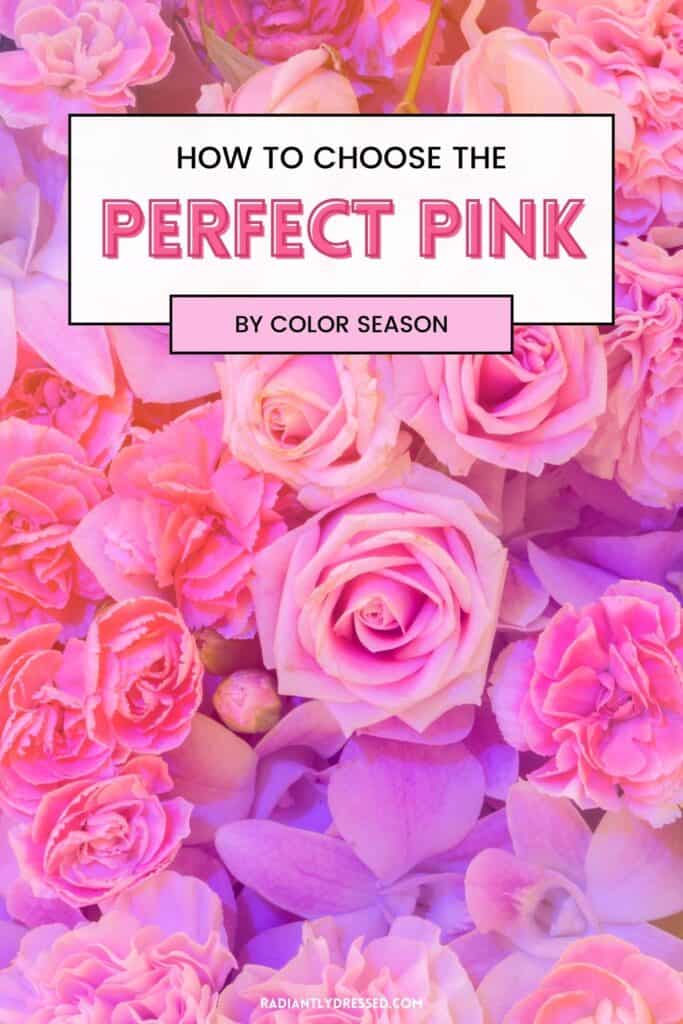
Pink is a versatile color that can complement any wardrobe, but finding the right shade to match your skin’s undertone is crucial. Your specific color season – whether it be Spring, Summer, Autumn, or Winter – determines which pinks are the most flattering for you.
Each season has its ideal pink shades that can enhance your natural features. For Spring, warmer and more vibrant pinks can bring out the best in your peachy or golden skin. Summers should look for soft, muted pinks to complement their cooler undertones.
Autumn individuals will find earthy pinks harmonize well with their warm, deep complexions. Winter seasons, characterized by cool undertones and striking features, shine in deep, saturated pinks.
Are you ready to discover the perfect pink for your season? Dive deeper into how you can confidently wear pink, no matter your color season.
Table of Contents
The Psychology of Pink
Wearing pink carries both psychological and cultural significance. This color can impact your mood and social perceptions, as well as hold different meanings across various cultures.
Pink is often associated with feelings of calmness and playfulness. When you wear pink, it can evoke a sense of relaxation and joy. Studies show that pink can reduce feelings of anger and aggression. The presence of pink has been used in some correctional facilities to pacify inmates.
Different shades of pink can convey different emotions. Light pinks tend to soothe, while vibrant pinks can increase energy and attract attention. Utilizing pink in your wardrobe can thus influence not only your own emotions but also how others perceive you.
Culturally, pink has a variety of meanings and influences. In many Western cultures, pink is traditionally associated with femininity and softness. It symbolizes love, compassion, and nurturing.
During certain periods, pink has been a symbol of rebellion and individualism. For instance, in the punk movement, bright pink hair and clothing were emblems of non-conformity.
Understanding these cultural nuances can help you make more informed choices about when and how to wear pink.
Understanding Color Seasons
Color seasons are a concept in fashion and beauty that relate to finding the colors that best match your natural features like skin tone, hair color, and eye color. There are 4 major seasons that split into 3 smaller sub seasons each:
- Spring – warm and light with bright contrast: clear spring, warm spring, light spring.
- Summer – cool and light and muted: light summer, cool summer, soft summer.
- Autumn – warm and dark with low contrast: soft autumn, warm autumn, deep autumn.
- Winter – cool and dark with high contrast: deep winter, cool winter, clear winter.
Here’s a quick way to get started in identifying your season:
- Observe your natural skin tone, eye, and hair color.
- Compare these to the typical characteristics of the four seasons.
- Notice how certain colors impact your appearance—do they make you look vibrant or washed out?
Want to find your season? Grab the DIY color analysis course today and find your best colors.
Tired of going round in circles trying to figure out your color season? Hack the same process used by professional color analysts to figure out your season from the comfort of your home, and stop feeling confused about color analysis with Personal Prism.
Now that you know a little more about color seasons, you’re on your way to choosing shades of pink that make you look your best!
The Perfect Pink for Spring Seasons
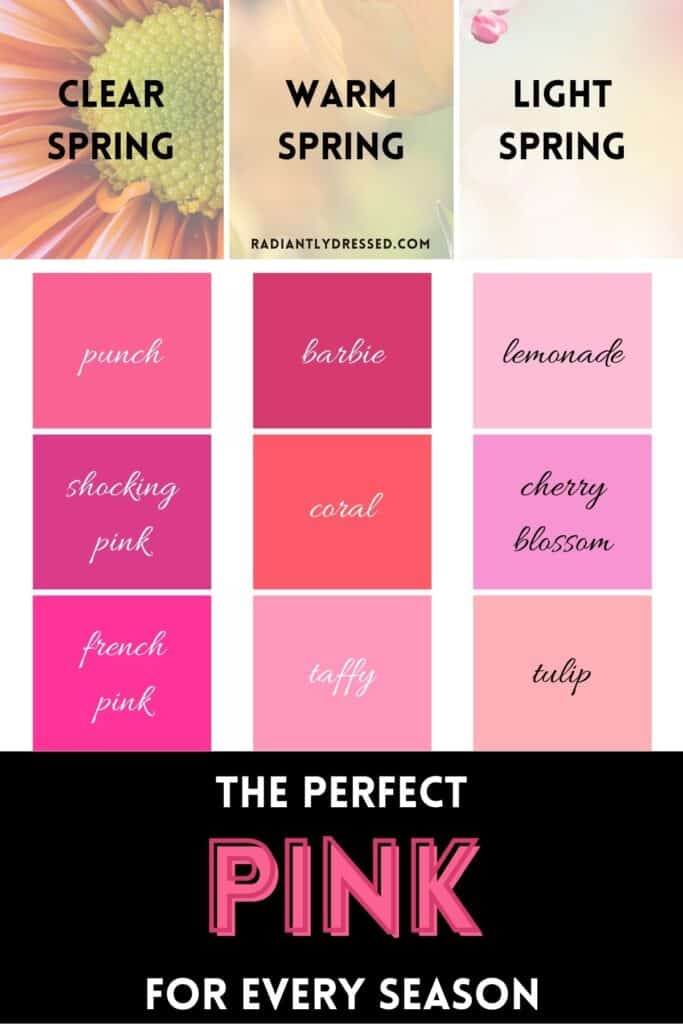
The three spring seasons are warm in undertone, overall light in value, and bright in chroma or saturation. The pinks for these seasons need to have those same characteristics. There is some crossover in the pinks that work, but slight adjustments can be made for changes in saturation and value.
For clear spring, consider bold, bright, pinks such as punch, shocking pink, and french pink.
For warm spring, stick with bright warm pinks like barbie, coral, and taffy.
Light spring needs slightly lighter versions of pink, such as lemonade, cherry blossom, and tulip.
The Perfect Pink for Summer Seasons
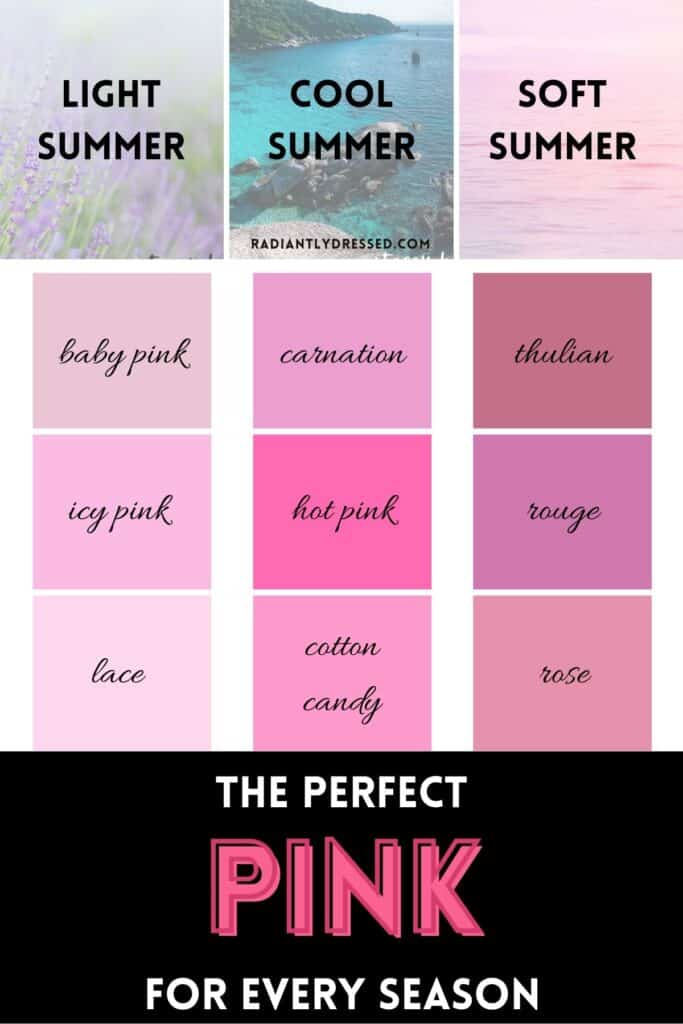
The three summer seasons are cool in undertone, overall light in value, and muted in chroma, not very saturated. Choosing pinks with those same characteristics will create a harmonious appearance. These pinks will work for all 3 summer seasons but reflect the variations in intensity and depth.
Light summer will do best in the most pastel versions of pink such as baby pink, icy pink, and lace.
Cool summer steals a bit of brightness from its sister season of winter and can wear shades like carnation, hot pink, and cotton candy.
Soft summer sticks with muted pinks such as thulian, rouge, and rose.
The Perfect Pink for Autumn Seasons
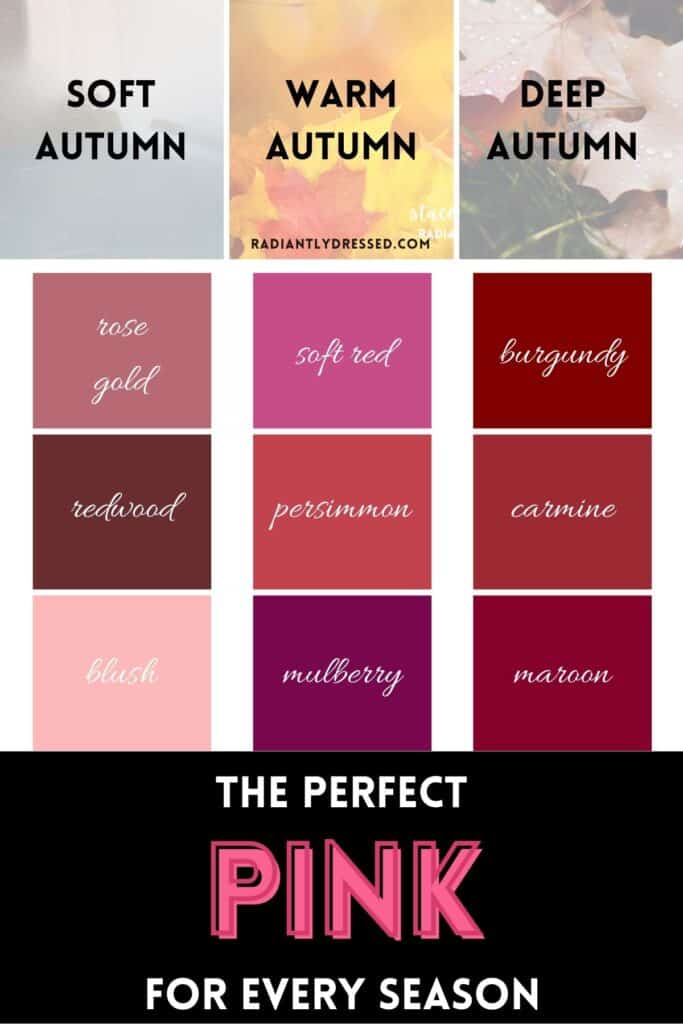
Autumn types are warm in undertone, overall dark in value, and muted in chroma, with a bit of muddiness to the colors. The three autumn seasons should choose pinks that mimic the soft characteristics of this type. You can always borrow from your sister seasons, but the pinks for each subseason show slight variations for chroma and value.
For soft autumn, consider muted pinks like rose gold, redwood, and blush.
Warm autumn learns into warm orangey-pinks such as soft red, persimmon, and mulberry.
Deep autumn is one of the darkest seasons and should stick to shades of pink like burgundy, carmine, and maroon.
The Perfect Pink for Winter Seasons
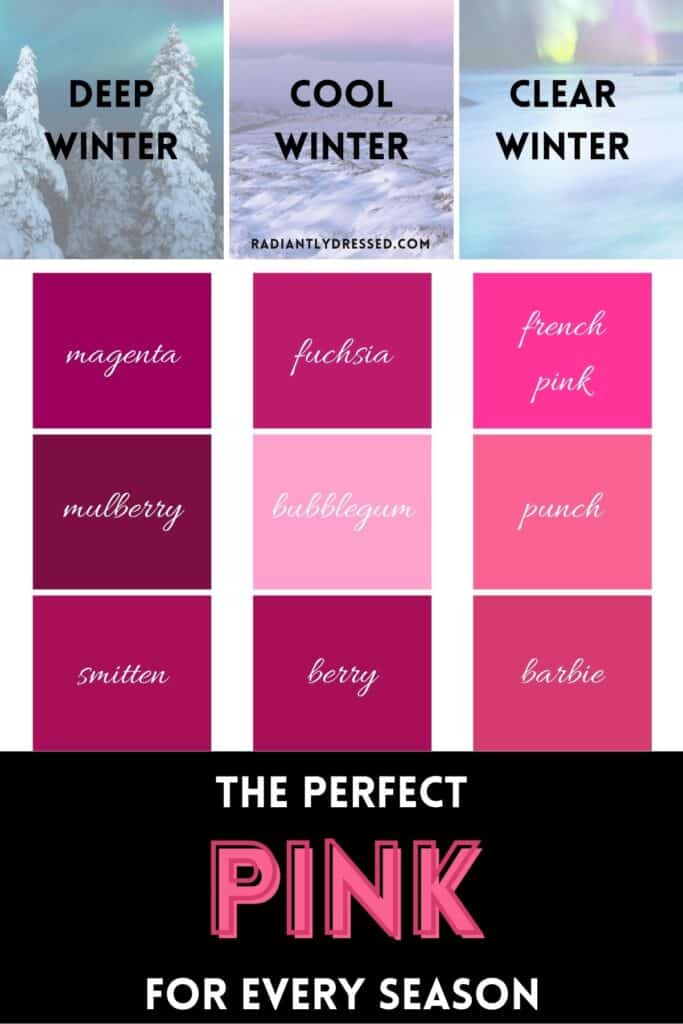
The three winter seasons are cool in undertone, darker in value, and exhibit a high degree of contrast or saturation. The pink for this season are bright, pink-based shades. The range can be worn by all winters, so choose based on your level of brightness or depth.
Deep winter needs dark pinks such as magenta, mulberry, and smitten.
Cool winter needs the bold true pinks like fuchsia, bubblegum, and berry.
For clear winter, choose the brightest versions of cool pink such as french pink, punch, and barbie.
Pink Styling Tips
Mixing Patterns and Textures
Mixing patterns and textures with pink can add depth and interest to your outfit.
- Patterns: Try pairing pink with stripes, florals, or polka dots. For a subtle look, combine a soft pink blouse with a floral skirt that features hints of pink. For a bolder statement, mix a pink plaid shirt with a patterned scarf.
- Textures: Incorporate different textures like silk, lace, or knitwear. A pink silk blouse under a chunky knit cardigan can create a visually appealing contrast, while a lace pink dress can add a delicate and feminine touch.
Layering with Pink
Layering is a fantastic way to incorporate pink into your wardrobe throughout the year.
- Spring and Summer: Opt for lighter layers like a pink cardigan over a white sundress or a pink denim jacket paired with a floral top.
- Fall and Winter: Choose heavier layers such as a pink wool coat over a neutral sweater or a pink turtleneck under a plaid blazer. Mixing pink with neutrals or darker colors can help balance the look and make it seasonally appropriate.
Pink as an Accent Color
Using pink as an accent color can instantly elevate your outfit and add a pop of vibrancy.
- Outfit Accents: A pink scarf, belt, or pair of shoes can brighten up a neutral outfit without overwhelming it. For instance, a beige or gray ensemble can come to life with a pink belt or shoes.
- Color Blocking: Pair pink with other bold colors like navy, green, or even red for a striking look. A pink top with navy pants or a pink skirt with a green blouse can create a dynamic and fashion-forward outfit.
Accessorizing with Pink
Accessorizing with pink is an easy way to infuse this cheerful color into your look.
- Jewelry: Consider pink gemstone jewelry like rose quartz earrings or a pink statement necklace. These pieces can add a touch of elegance and femininity.
- Bags and Shoes: A pink handbag or pair of shoes can be the perfect finishing touch to your outfit. Whether it’s a pastel pink clutch for a special occasion or hot pink sneakers for a casual day out, these accessories can make your look more cohesive and stylish.
- Hats and Scarves: A pink hat or scarf can be both functional and fashionable. They not only keep you warm but also add a delightful splash of color to your ensemble.
These pink styling tips can help you creatively incorporate this versatile color into your wardrobe, ensuring you look stylish and feel confident in any season.
Perfect Pink Color Pairings
Pink is a versatile color that enhances your wardrobe year-round. Whether it’s the gentle pastels of spring, the bright hues of summer, the earthy tones of autumn, or the cool contrasts of winter, there’s a perfect pink pairing for every season.
Spring
- Pink and Soft Lavender: Fresh and romantic.
- Pink and Sage Green: Soft and serene.
- Pink and Butter Yellow: Vibrant and cheerful.
Summer
- Pink and White: Crisp and clean.
- Pink and Aqua Blue: Bright and playful.
- Pink and Coral: Lively and tropical.
Autumn
- Pink and Mustard Yellow: Deep and earthy.
- Pink and Burnt Orange: Warm and inviting.
- Pink and Olive Green: Rich and luxurious.
Winter
- Pink and Charcoal Gray: Bold and striking.
- Pink and Navy Blue: Classic and sophisticated.
- Pink and Silver: Festive and crisp.
When selecting your pairings, consider the shades and undertones that work best together. Experiment with different combinations to find what makes you feel confident and stylish each season.
Care and Maintenance of Pink Clothing
Ensuring that your pink clothing remains vibrant and fresh requires proper care and attention. Different shades of pink may require slightly different care techniques, but a few general rules apply across the board.
Washing Tips:
- Always check the care label before washing.
- Use cold water to help preserve the color.
- Turn garments inside out to reduce friction and fading.
Using Detergents:
- Select a gentle detergent designed for colored fabrics.
- Avoid bleach, as it can cause discoloration.
Drying Methods:
- Air-dry pink clothing whenever possible to prevent shrinking and fading.
- If using a dryer, opt for a low heat setting.
Stain Removal
For stain removal, treat the stain as soon as possible. Gently blot the area with a mixture of water and a mild detergent. Never rub a stain as it can spread and set deeper into the fabric.
Storage
Store pink clothing away from direct sunlight to prevent fading. Folding garments neatly and using acid-free tissue paper can also help maintain their shape and color.
Incorporating Pink into Your Work Wardrobe
Incorporating pink into your work wardrobe can add a touch of femininity and elegance while maintaining a professional appearance. Here are some tips on how to seamlessly integrate pink into your office attire:
Pink Blouses and Tops
- Classic Button-Downs: A pink button-down shirt can be paired with tailored trousers or a pencil skirt for a polished and sophisticated look. Opt for shades like blush or dusty pink for a subtle, professional vibe.
- Blouses with Details: Choose pink blouses with interesting details such as ruffles, bows, or pleats. These can add a stylish twist to your work outfit without being overly casual.
Pink Dresses
- Sheath Dresses: A pink sheath dress is a versatile piece that can be dressed up or down. Pair it with a blazer and neutral pumps for a refined look.
- Wrap Dresses: A pink wrap dress can be both flattering and comfortable. Choose a modest length and pair it with simple accessories to keep it work-appropriate.
Pink Blazers and Outerwear
- Blazers: A pink blazer can be a standout piece in your work wardrobe. Wear it over a white blouse and black trousers for a chic, modern look. Soft pinks can convey approachability, while brighter pinks can make a bold statement.
- Coats: A pink coat can add a pop of color to your outerwear. Look for structured styles in shades like rose or salmon to keep the look professional.
Pink Accessories
- Scarves and Ties: A pink scarf or tie can add a subtle hint of color to your outfit. These accessories can be particularly effective in neutral or monochrome outfits, providing a touch of warmth and interest.
- Bags and Shoes: Incorporate pink through your accessories like handbags and shoes. A blush pink handbag or pair of pumps can be the perfect finishing touch to a classic work outfit.
Pink Skirts and Pants
- Skirts: A pink pencil skirt or A-line skirt can be paired with a crisp white shirt or a neutral blouse. This combination is both stylish and professional, making it perfect for the office.
- Trousers: Pink trousers can be a bold choice for workwear. Pair them with a neutral top and blazer to balance the look and keep it sophisticated.
Mixing and Matching
- Neutral Pairings: Pair pink with neutral colors like black, white, gray, and navy to maintain a professional appearance. These combinations can create a balanced and cohesive look.
- Color Blocking: For a more fashion-forward approach, try color blocking with complementary colors like burgundy, teal, or even mustard. Ensure that the overall look remains elegant and not too overwhelming.
Incorporating pink into your work wardrobe can refresh your professional attire and showcase your personal style. By choosing the right shades and combining them with classic pieces, you can create a sophisticated and stylish work wardrobe that reflects your confidence and individuality.
Frequently Asked Questions about How to Wear Pink
What should someone consider when choosing pink clothing for their seasonal color analysis?
You should identify your undertone first and choose pinks that align with those tones. Warm undertones should go for warm pinks, while cool undertones look best in cooler shades. Contrast and clarity also play roles, so consider how vibrant or muted your pinks should be.
What colors should I avoid pairing with pink?
While pink is versatile, it’s best to avoid pairing it with colors that might clash, such as certain shades of red or overly vibrant greens unless you’re intentionally going for a bold, high-contrast look. Stick to complementary or neutral colors for a cohesive appearance.
How can I make pink look more edgy and less girly?
To give pink an edgier vibe, pair it with black leather or denim. A pink top under a black leather jacket or pink accessories with ripped jeans can create a stylish, edgy look.
Can I wear pink in the fall and winter?
Definitely! Choose richer, deeper shades of pink like burgundy or magenta for fall and winter. Layer with darker colors like charcoal, navy, or forest green to create a season-appropriate look.
How can I add pink to my wardrobe if I prefer a more neutral palette?
If you prefer neutrals, start by incorporating pink through accessories. A pink scarf, handbag, or shoes can add a subtle pop of color without overwhelming your neutral wardrobe.
How do I style pink for a casual, everyday look?
For a casual look, pair pink tops with jeans or casual trousers. Pink t-shirts, sweaters, or hoodies can be easily styled with denim for a relaxed, everyday outfit.
Related Color Analysis Articles:
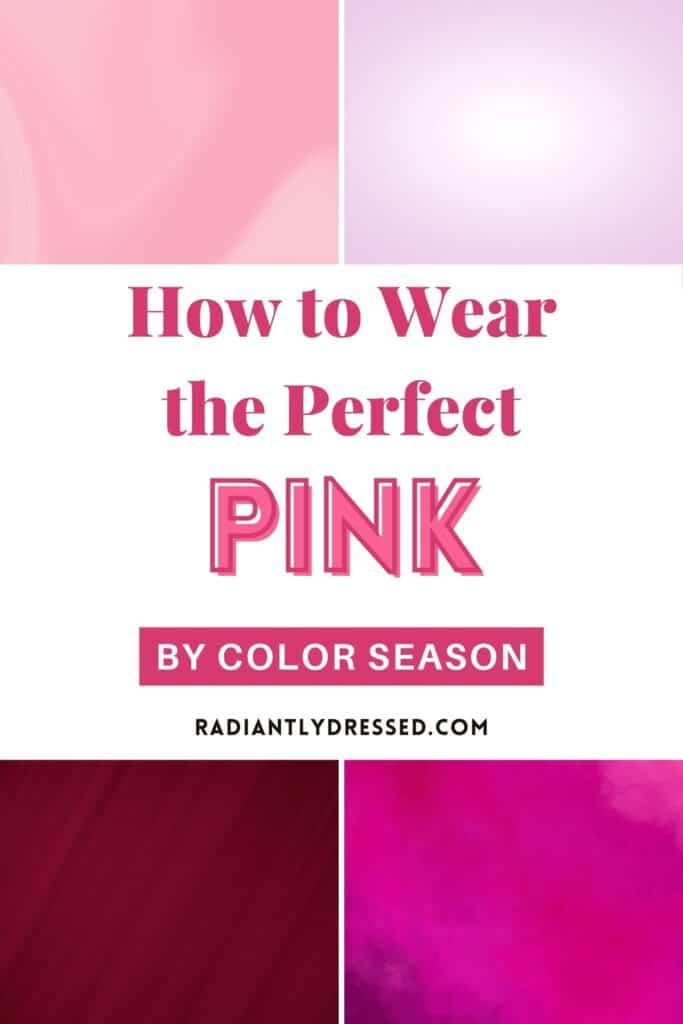
Discover how to find the perfect shade of pink for every color season, enhancing your natural beauty and personal style year-round.
Stacey is the owner and creator behind Radiantly Dressed. She is a certified image consultant and AICI member focusing on creating simplicity in wardrobes via color and style.

